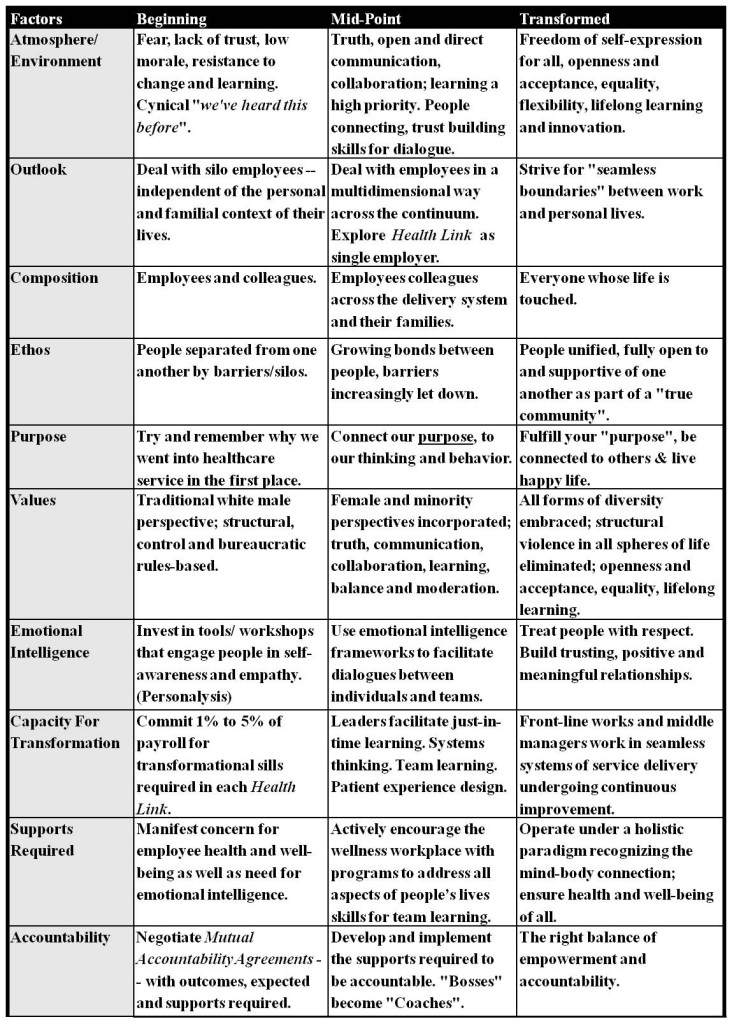The complexity of the Health Link challenge seems to be waking up the systems thinkers among us. At conferences I attend, they are coming out of hiding and getting actively engaged in talking about “designing a better delivery system.” Wow! An environment that is “safe” for systems thinkers.
Oh, those poor lonely systems thinkers.
I remember going to Peter Senge’s Systems Thinking In Action Conference every year for about ten years. These were gatherings of about 800 people — from all over the world, and from multiple disciplines and perspectives. Everyone was sharing what we were learning in the field of “applied systems thinking”.
Participants — including myself — found it almost therapeutic to be among such a mass of people who think the same way as they do. Systems thinkers don’t do very well in a world governed by rigid rules, mandatory processes, common templates and the “one-size-fits-all” assumptions of those who seek to control, or to maintain the “illusion of control”.
When you learn about the critical success factors present in the 30 percent of organizations that successfully transformed, the most common is: systems thinking skills.
As Senge says, “Systems thinking does not mean ignoring complexity. Rather, it means organizing complexity into a coherent story that illuminates the causes of problems and how they can be remedied in enduring ways.” It also means designing effective changes in the right places in the system — the key leverage points within a complex adaptive human system as set out in such systems thinking design tools as the Strategic Alignment Model.
The phrase “system sensing” serves to remind us that perceiving a system is not merely an intellectual exercise: it involves giving validity to intuition, people’s senses and instincts, as well as measurable data. Systems sensing is about following hunches and curiosities. A wide variety of systems whisper to us everyday, requiring our keen sensitivity and attentiveness to their signals. Systems typically do not start screaming until they are in crisis. At that point, desired adjustments require far more time and money.
Systems sensing involves feeling, naming, and exploring the dilemmas we find ourselves in daily. These dilemmas are typically entered into unintentionally and unknowingly. Unearthing and inquiring with compassion into these dilemmas can, over time, cultivate deeper understandings. Holding a systems perspective, or “holding the whole,” means recognizing that apparent opposites can be true, staying curious and patient with inquiry until the whole system in which these opposites can “make sense” is revealed. Helping people discover and learn about the systems they perpetuate involves practice — asking, and receiving questions in ways that value the relationship with the learner — exchanging questions from the heart as well as the mind.
A person cannot develop the discipline of systems sensing without practicing compassionate and passionate inquiry of themselves and others. Perhaps our habits of communicating have become a kind of prison for us. Our “skilled incompetency” in asking questions maintains the very defenses we need to eliminate if we are to learn together. In the absence of questions exchanged in genuine curiosity, our ability to generate shared insights and meaning is undermined.
To the extent that expert models persist, systems sensing, which requires going within, as well as outside for answers, cannot be realized. Systems sensing values everyone’s contribution because everyone has a unique perspective from living in the system. A system can never be fully perceived with just one pair of eyes and ears. One person’s biases tend to filter out vital information. It is only with multiple, often divergent perspectives that the rich diversity of a system can be adequately represented. The ability to accept different points of view is present in community and desperately needed for us to develop the collective organs of perception which can more adequately represent a whole system.
System Thinking is a way of thinking about, and a language for describing and understanding the forces and interrelationships that shape the behavior of systems. The discipline of systems thinking enables us to see beyond the structures and barriers to the underlying processes that are driving system behavior.
Just before he died, Deming changed his old 80/20 Rule to 93-7. He concluded that 93% of the time he encountered dysfunctional systems, they were due to bad organizational design and alignment, while only 7% of the time the problem was due to “people problems”. But half the time that there were “people problems”, the root cause was actually a lack of skills and training. So, real people problems are actually only 3.5% of the problem.
While Deming said this 30 years ago, MOHLTC, the LHINs, our HSP’s CEOs, and our silo governance Boards continue to blame people for sub-optimal performance. Other than our addiction to structural “fixes-that-fail”, we don’t normally apply systems thinking to system design.
That’s because our so-called “system designers” are not designing systems that work, rather, they are simply focused on power — i.e. who should be “the boss” — and design around that decision. What the Minister of Health as asked for is “people-centred” system designs.
While we know that “change is hard”, we must understand that barriers to organizational and system change are not immutable forces of nature — they are human designs and creations. Over the years, many people — through governments led by all three political parties — have engaged in constructing these barriers based on their assumptions, expectations, habits and desires.
Leaders — in government/LHINs/management of HSPs/Governance — need to be prepared to start the process of altering the DNA of the delivery system. But because every Health Link, every LHIN and every HSP is different, the changes required, the sequence of the journey, the realities of local circumstances will require bottom-up, not top-down solutions.
Health Links that will succeed will be those who become true Learning Organizations.
Peter Senge describes a Learning Organization as “a group of people who are continually enhancing their capacity to create the results they want”. He believes that the building of learning organizations requires basic shifts in how we think and interact. It is an exercise in personal commitment to being open to learning. Without communities of people who are genuinely committed, there is no real chance of moving forward.
According to David Carnevale, author of Trustworthy Government, one of the key differences between learning organizations and traditional controlling organizations “is that deeply ingrained defensiveness so characteristic of low-trust, traditional bureaucratic organizations that undermines necessary learning. Trust expedites learning.”
Carnevale describes trust as “an expression of faith and confidence that a person or an institution will be fair, reliable, ethical, competent, and nonthreatening”. Trust has also been explained as having faith that someone is able to, and wants to control their “dark side” as it would affect oneself or others.
All too often, however, work organizations destroy their employees’ trust. Carnevale writes that many people go to work “with guarded, suspicious, and cynical attitudes. They have lost faith in their organizations. Their hopes and expectations have been mismanaged. The costs of mistrust and cynicism are high. These emotions corrode organizations and destroy high-performance. The loss of trust is a loss of system power in organizations. Trust is an integrative mechanism – the cohesion that makes it possible for organizations to accomplish extraordinary things.
Trust is social capital. It reduces conflict, improves communication, eases cooperation, enhances problem-solving, reduces stress, enables people to realize more satisfactory relationships, amplifies organizational learning, an advances change. Trust is a positive mindset. It needs to be restored in organizations”.
It is discouraging for front-line care providers to learn through the media about “connected consultants” who pocketed millions in untendered contracts, and about the whole Ornge scandal that costs taxpayers more millions, and about the bottom-line pay packets to some of our senior hospital managers.
The rampant entitlement mentality among senior managers and bureaucrats has created a genuine lack of respect in our healthcare hierarchy.
How do we shift that dynamic?
Carnevale says that “healthy learning organizations are managed with the objective of liberating and using employee know-how to improve work processes. The emancipation of employee know-how is enabled through a different philosophy of organization and job design, communication patterns, labor-management relations, participatory methods, and other processes that reduce the climate of fear and allow staff the necessary psychological peace of mind to fully engage their work”.
Charles Handy, a scholar in the field, supports Carnevale’s position. He argues that learning organizations must be built on an assumption of competence — meaning that each individual can be expected to perform to the limit of his or her competence, with the minimum of supervision.
Traditional bureaucratic organizations are dominated by the need for control and conformity — assuming that workers are incompetent and therefore must be carefully managed. In turn, this creates high degrees of mistrust, defensiveness and fear — all of which undermine learning.
In learning organizations, the assumption of competence is supported through the encouragement of curiosity, creativity and innovation. The people who deliver the organization’s customers are encouraged to use their know-how to improve work processes. While successes are a cause for celebration, Learning organizations must also accept and forgive mistakes as part of the learning process. They must be open to learning from their “best mistakes”.
A learning organization must be built on trust, togetherness and a sense of true community. Few, if any, of the problems organizations face nowadays can be handled by one person acting alone. The need for togetherness, or team learning, both to get things done and to encourage the kind of innovation that is essential to any growing organization creates the conditions for trust.
Trust, in turn, improves togetherness and creates a culture and a community in which learning can flourish.
At this stage of the development of Health Links, the partner CEOs and senior teams will either be taking their skills for collaboration to a new level, or settle into their entrenched same/old silos with no real attempts to shift thinking and behavior as the partners redesign the patient experience as they journey across the continuum-of-care.
Art Frohwerk, the inventor of the Experience Design Storyboard — which is now used extensively in leading-edge organizations to “design the patient experience” — says that in a silo-based system, patients are abandoned and mostly on their own as they journey across the continuum from hospital to home care, to chronic care, to nursing homes and palliative.
Storyboarding can be used to follow the patient journey across the health services delivery system, in order to address how the patient experience can be improved.
However, at a higher level of altitude from the patient’s clinical experience is the organizational design that produces the results that are being achieved.
A best practice systems thinking-based model for achieving organizational alignment is the Strategic Alignment Model (see below) that simply teaches us that in order to achieve your mission/vision/outcomes, you need to align the components of Structure, to the strategy; the components of Culture to the strategy; and, the components of Skills to the strategy.
Successful transformation occurs when the interdependent parts are designed to operate in sync with one another — and with the organization’s/Health Link’s strategy.
Successful transformation will not result from a series of isolated actions, but from orchestrating the right combination of interactions.

FORWARD THIS BLOG TO PEOPLE YOU THINK WOULD BENEFIT FROM A BLOG ON SYSTEMS THINKING AND SYSTEM DESIGN.







